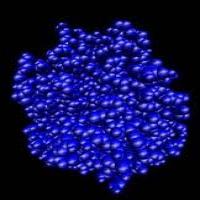Trypsin

Product description:Trypsin is a serine protease found in the digestive system of many vertebrates, where it hydrolyses proteins.Trypsin is produced in the pancreas as the inactive proenzyme trypsinogen. Trypsin cleaves peptide chains mainly at the carboxyl side of the amino acids lysine or arginine, except when either is followed by proline. It is used for numerous biotechnological processes. The process is commonly referred to as trypsin proteolysis or trypsinisation, and proteins that have been digested/treated with trypsin are said to have been trypsinized.
Function:Trypsin in the duodenum acts to hydrolyse peptides into amino acids. This is a necessary step in protein absorption because peptides (though smaller than proteins) are too big to be absorbed through the lining of the small intestine. Trypsin catalyses the hydrolysis of peptide bonds.
Trypsin is produced in the pancreas in the form of the inactive zymogen trypsinogen. When the pancreas is stimulated by cholecystokinin, it is then secreted into the first part of the small intestine the duodenum via the pancreatic duct. Once in the small intestine, the enzyme enteropeptidase activates it into trypsin by proteolytic cleavage. Trypsin can then function to activate additional trypsinogen (autocatalysis), so only a small amount of enteropeptidase is necessary to start the reaction. This activation mechanism is common for most serine proteases, and serves to prevent autodegradation of the pancreas.
Properties:Trypsins have an optimal operating pH of about 8 and optimal operating temperature of about 37°C.
The activity of trypsins is not affected by the inhibitor tosyl phenylalanyl chloromethyl ketone, TPCK, which deactivates chymotrypsin. This is important because, in some applications, like mass spectrometry, the specificity of cleavage is important.
Trypsins should be stored at very cold temperatures (between ?20°C and ?80°C) to prevent autolysis, which may also be impeded by storage of trypsins at pH 3 or by using trypsin modified by reductive methylation. When the pH is adjusted back to pH 8, activity returns.
Disclaimer: the information on this website is from the internet for reference only. Please refer to the actual instructions attached to the product and the final interpretation is owned by the company.
 for: Product Quotation ( Product suppliers),COA (Certificate of Analysis), New Sales
for: Product Quotation ( Product suppliers),COA (Certificate of Analysis), New Sales
Promotion,New Products,And any other assistance.
 After send online enquiry, we will reply you as soon as possible, if not get any response on time please contact us by Tel or Email.
After send online enquiry, we will reply you as soon as possible, if not get any response on time please contact us by Tel or Email.
1. Email: sales@aushealthingredients.com
2. Tel: +86 592 5365887
3. WhatsApp: +86 189 6516 2351
4. Send enquiry online:


